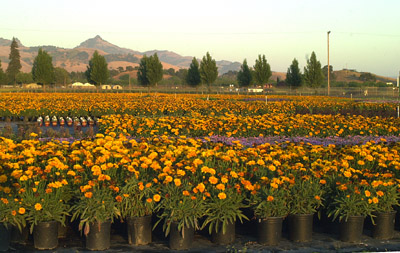
The agricultural industry continues to bloom in San Benito
County with a 6-percent increase in overall revenue for 2002 that
totaled nearly $215 million.
The agricultural industry continues to bloom in San Benito County with a 6-percent increase in overall revenue for 2002 that totaled nearly $215 million.
The fastest growing segment in local agriculture was nursery stock that generated a gross estimated income of $28.96 million in 2002, according to the county’s 2002 crop report, which was released Tuesday.
“The bottom line is that agriculture is alive and well in San Benito County,” San Benito County Agricultural Commissioner Mark Tognazzini said. “Not that agriculture has ever gone out, but the profile of the crops has changed.”
Because of the area’s temperate climate and rich soil, farmers can grow more than 60 varieties of crops, which include everything from Bok Choy to Burdock, or from Surchokes to Swiss Chard.
Nursery stock, which includes a variety of flowers, wholesale potted plants and many types of young trees, realized an increase of more than $3.7 million from 2001, a nearly 12-percent increase.
Following closely behind nursery stock with the largest increase in income was baby lettuce. The popular salad ingredient brought in approximately $24.5 million in 2002, an increase of nearly $9 million or 59 percent increase from the $15.4 million generated in 2001, according to the 12-page report.
“We are the baby lettuce capital of the world,” Tognazzini said. “The biggest production and shipping that there is, is done from here.”
Although lettuce in general has always been one of the county’s signature crops, the recent introduction of baby lettuce, produced year-round in the state, has skyrocketed, Tognazzini said.
There are several baby lettuce varieties grown within the county, including Red Royal oak leaf, which is six-inches in diameter and has rough-cut leaves dark red in color. Baby lettuce is one of the major ingredients used in the prepackaged salad mixes found in grocery stores.
There are approximately 14 varieties of baby lettuce grown locally.
“Your crops per acre (for baby lettuce) increased with 2,200 acres more production,” Tognazzini said.
He said it was not that more acres of land have been devoted to the production of baby lettuce, but that because baby lettuce can be grown to maturity in about two months, farmers can generate four harvests to five harvests a year off the same acreage of land.
Overall, lettuce production, which includes head, leaf and baby lettuce, was about 22 percent more in 2002 than from the previous year. In 2002, lettuce production generated $56.5 million, about $10.5 million more than the $46 million in 2001.
While most major categories of agriculture saw a significant increase, there were a few decreases, although most of the declines in production were slight. Wine grape production went from $15.85 million in 2001 to $15.61 million in 2002, dropping about a 1.5 percent.
Walnut production declined by about $195,000; apple production was down by about $128,000 and radicchio production fell from $3.88 million in 2001 to $2.57 million in 2002, a decrease of $1.31 million, according to the report.
Livestock witnessed a noticeable decline, with cattle going from $14.4 million in 2001 to $9.7 million in 2002, a 32-percent decrease, and miscellaneous livestock and poultry decreased from $18.1 million in 2001 to $13 million in 2002, about a 28-percent fall, the report cited.









